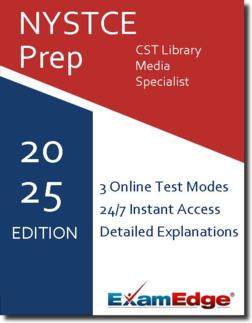NYSTCE CST Library Media Specialist (074) Practice Tests & Test Prep by Exam Edge - Topics
Based on 17 Reviews
- Real Exam Simulation: Timed questions and matching content build comfort for your NYSTCE CST Library Media Specialist test day.
- Instant, 24/7 Access: Web-based NYSTCE CST Library Media Specialist practice exams with no software needed.
- Clear Explanations: Step-by-step answers and explanations for your NYSTCE exam to strengthen understanding.
- Boosted Confidence: Reduces anxiety and improves test-taking skills to ace your NYSTCE CST Library Media Specialist (074).

Understanding the exact breakdown of the NYSTCE CST Library Media Specialist test will help you know what to expect and how to most effectively prepare. The NYSTCE CST Library Media Specialist has 90 multiple-choice questions and 1 essay questions. The exam will be broken down into the sections below:
| NYSTCE CST Library Media Specialist Exam Blueprint | ||
|---|---|---|
| Domain Name | % | Number of Questions |
| The School Library Media Program | 07% | 6 |
| Roles and Responsibilities of the Library Media Specialist | 10% | 9 |
| Information, Technology, and Literary Resources | 12% | 11 |
| Collection Development and Resource Management | 10% | 9 |
| Skills for Multiple Literacies | 10% | 9 |
| Individual and Collaborative Learning and Inquiry | 11% | 10 |
| Social Responsibility and Legal and Ethical Issues | 7% | 6 |
| Administration of the School Library Media Program | 13% | 12 |
| Analysis, Synthesis, and Application ()Constructed-Response) - Not Included | 20% | 18 |


